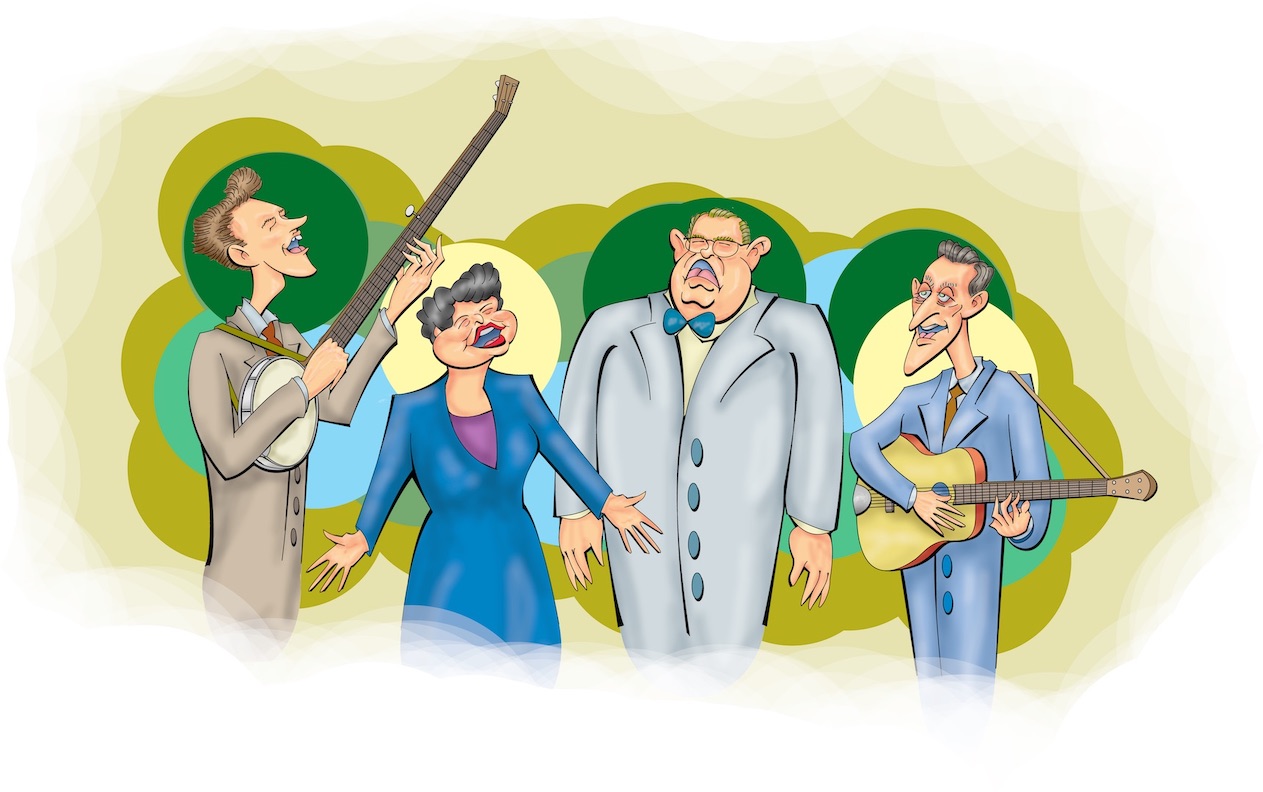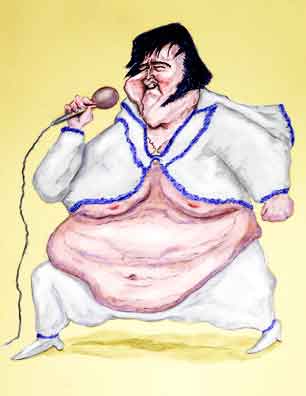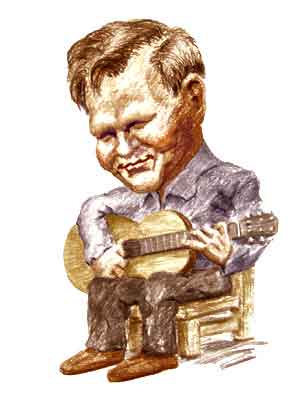Jean Ritchie

Admit it. If you don't like the singing of Jean Ritchie, then, dang it, ...
 YOU DON'T LIKE
YOU DON'T LIKE
FOLK
MUSIC!!!!
Jean in fact was one of the principle sources for Alan Lomax's magisterial Folk Songs of North America, a book which, alas, is out of print. As the youngest of fourteen kids born to Balis Ritchie and Abigail Hall1, Jean grew up in a place where if you wanted music it not only had to be live music but you had to make it yourself. So it's no surprise that everyone in her family - nuclear and extended - were musical people2.
Footnote
The Ritchie siblings in order of appearance are Raymond, Truman, Balis Wilmer, May, Ollie, Mallie, Una, Kitty, Patty, Edna, Jewel, Opal, Pauline, and (last but not least) Jean.
Footnote
As an indicator of the Ritchie family heritage, when the famous English folklorist Cecil Sharp was traveling through America collecting folk songs in the early 20th century, some of his sources were the Ritchies in Kentucky.

Alan Lomax
Jean was a source.
Jean was born on December 8, 1922, in Viper, Perry County, Kentucky, which is in fact fairly populous for an unincorporated community. The usual number given is over 20003.
Footnote
You must be careful, though. One "search" - note the quotes - for the demographics of Cookietown, Oklahoma, yielded a population of 93,025. Given the fact that the county in which Cookietown resides (Cotton) has less than 6,000 people, one must give pause when using quick Internet searches. A more in-depth search indicates the Cookietown population at the turn of the Millennium was six (6).
Jean was the surprise! baby of the family. Her mom was 44 years old when Jean was born4 and Jean's description of the Ritchie household - remember there were 14 kids - gives a feel of a constant bordering on chaos, controlled chaos perhaps, but chaos nonetheless. The house was built by her dad (with a little help from their friends) and was considered one of the best in the county. The house was situated on a farm but her dad also had a number of jobs which included working at a local store and teaching school.
Footnote
The eldest of the Ritchie kids, May, was over a quarter of a century Jean's senior, and Jean was younger than May's daughter.
Although by the standards of the place and time, you can't call the Ritchie's poor, still much of the family's sustenance was from the farm produce. By the time she was ten Jean was working in the fields which in the summer was an all day occupation. To pass the time and relieve the tedium, they would sing songs.
But Jean's folks didn't expect the kids to stay on the farm. Instead, they encouraged their brood to get an education - and not just to stop after high school. Fortunately this was the time when a university education was affordable, and most of the Ritchie kids went to college.
However, it is easy to idealize the rural mountain life. In her autobiography, The Singing Family of the Cumberlands, Jean tells how she lost the end of her big toe simply by stubbing it against a rock (the kids often went barefoot). There were no physicians around and she was excruciatingly treated at home. The injury kept her home from school for some time.
Also spare-the-rod-spoil-the-child philosophy was practiced in the extreme and in a way that today would be - to put it mildly - completely unacceptable if not criminal. One passage which departs from the book's usual light hearted tone is when Jean tells how her father once gave her an extended and merciless beating with apple tree branches and rose bush switches (complete with the thorns) for what was nothing more than mild and under the circumstances understandable childhood stubbornness. The detail in which Jean relates the episode makes for harrowing reading even in our more jaded era.
Jean learned most of her songs from her family members (the Ritchies didn't even have a radio until 1940). But she had a natural bent for scholarship and soon realized that the family's history and its music were inseparable. Then when her teacher assigned the kids to write about their family, her mom said Jean should go talk to her Uncle Jason.
"Uncle" Jason was actually Balis's first cousin, not Jean's Uncle. And he did live some distance off. And although it was Abigail's suggestion that Jean talk to Jason, she told Jean it was too dangerous for a young girl to travel in the hills and dells by herself. So of course Jean immediately hied off on her own.
Jean took a bus to Hazard (about 10 miles away) and kept going to the stop which was closest to Jason's home. She still had to walk the last five or six miles before she found Uncle Jason sitting on his porch.
It was almost as if Jason had been expecting her. In fact he had heard of Jean from her mom and he had figured she would show up before long. They spoke for some time about the family and their musical heritage. Then Jean headed on home.
After high school Jean decided to go to college, and in 1946 she graduated from the University of Kentucky. She had specialized in social work and moved to New York City to take a job at the Henry Street Settlement which was (and is) a non-profit organization to provide social services. Among the services was extra curricular art education for the kids, and one of Jean's jobs was to teach music to the kids.
For someone of her background, interests, and talent, Jean had landed in the right place at the right time. In the 1940's New York City had become THE center of what's been called the Folk Revival. It was there you had Woody Guthrie, Lee Hays, Burl Ives, Theodore Bikel, Josh White, and of course, Pete Seeger. By the end of the decade all had appeared on national broadcasts.
But lesser known to the general public was the father and son team of John and Alan Lomax. As a young man growing up in Texas, John began collecting cowboy songs from the real cowboys he had known since he was a boy. His book "Cowboy Songs and Other Frontier Ballads" was published in 1910 and although not all of the songs had the music, many were printed for the first time. Among the now-classic tunes included were "The Old Chisholm Trail", "Get Along Little Dogies", and "Home on the Range"5.
Footnote
Of course, there are predecessors for the cowboy songs that can be found documented down through the years. But the best known versions today are those published by John.
But there wasn't a lot of money in researching cowboy songs. So John worked as a college administrator and bank executive. However, after some financial and personal reverses, John decided to try to earn a living by doing what he liked.
With his bonafide credentials as a published author, John was able to get a grant from the Library of Congress to collect folksongs. The "grant" was mostly the loan of a massive direct-to-disc recording machine that he lugged around in the trunk of his car, and he began traveling the country to find people who would record the songs they had learned from friends and family. To keep expenses down sometimes John would camp out at night by the side of the road.
Alan joined his dad and got hooked on the music. He was along on the trip when they stopped at the Louisiana State Penitentiary at Angola and recorded the singing and guitar playing of State Prisoner 19469 Huddie Ledbetter. And yes, by the time Jean got to New York, Leadbelly was part of the folk scene.
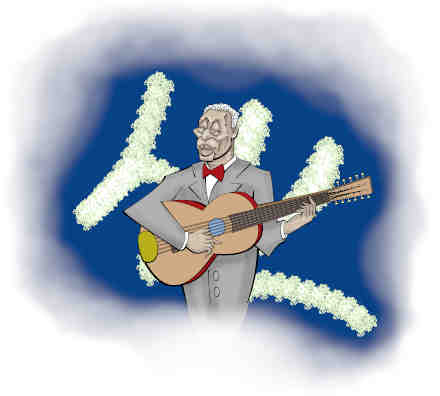
Huddie Ledbetter
Leadbelly
Of course, by the mid-1930's John wasn't getting any younger (he was born in 1867) and he pretty much turned the hefting of the Folk Song Revival to Alan's shoulders. In 1936 Alan became the director of the Archive of Folk Song at the Library of Congress, and in 1940 he helped arrange a "Grapes of Wrath6" benefit concert in New York for the migrant workers of the Southwest. Both Pete Seeger and Woody Guthrie performed7.
Footnote
The concert was named after the novel The Grapes of Wrath which was published by John Steinbeck in 1939. It told the story of Tom Joad and his family as "dust bowl refugees" who left Oklahoma for California. Woody Guthrie wrote a song titled "Tom Joad" which briefly but accurately outlines the story although to do so took of two sides of a 78-rpm single. Woody's song was released by RCA Victor in the collection Dust Bowl Ballads. In 1940, the book was made into a film which starred Henry Fonda as Tom. As usual the screenplay made changes from the book to make the movie more palatable for the public.
Footnote
Woody's performance was widely praised but Pete said his own efforts were amateurish. He was so discouraged that he left right after his songs and didn't hang around to meet Woody.
When in New York Alan was a frequent visitor to the Highland Settlement School and he soon met Jean. He immediately recognized her as an authentic folk singer who had learned her repertoire from oral tradition - not from books, recordings, or the radio. When he told her he wanted to record everything she knew, she said that might take a while. After all, she knew about 300 songs. But Alan said that was fine and soon Alan had one of his most valuable archives.
Of course, it wasn't all work and no play in New York City, and Jean would sing at parties and other get-togethers. That was fine since by then she was used to singing in front of people. But when a local school administrator asked her to perform for the kids she was surprised when he said they would pay her $25. That was something new. Actually getting paid to sing folk songs.
By the late 1940's consumer television was just getting started and over 90% of households still had no sets8. But radio was still ubiquitous. New York was replete with stations and the listeners could enjoy a wide spectrum of entertainment. And yes, some programs featured folk songs and one show was hosted by Oscar Brand on WNYC public radio9.
Footnote
Although commercial television had been around since the 1930's consumer television came much later and it wasn't until 1953 that 50% of the US households had the tube.
Footnote
Oscar, like Jean, had a long and distinguished career and was actively performing well over half a century after he met Jean. In June of 2005, one young man was bitterly disappointed when he was walking by the New York Historical Society and saw he had missed a performance by Oscar the night before. He had to console himself with purchasing an album where Oscar sang presidential campaign songs from 1789 to 1996 - without doubt one of Oscar's best albums.
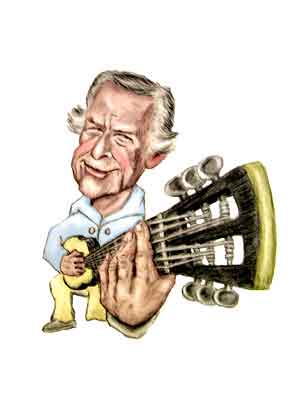
Oscar ...
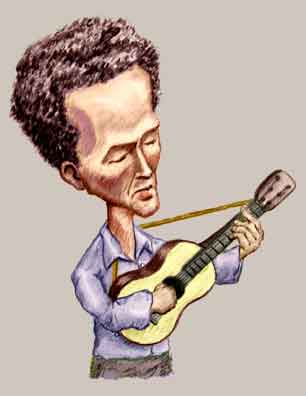
... and Woody



